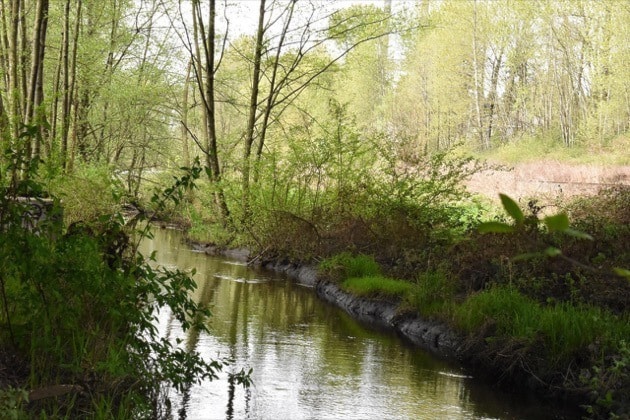Along the walkway in the Delta Nature Reserve, a channel of water slowly wends its way towards the Fraser River.
Grass overhangs its banks and ripples appear on the sandy bottom. In one section, where a fallen branch creates a deeper pool, the waters rise over the edge and filter through the muddy gravel on the path.
This channel is the Northeast Interceptor Canal, an engineered waterway that moves the water from the upper part of Cougar Creek down to the Fraser River. It’s a popular spot for dogs to take a summer swim, but few people realize it is part of a salmon-sustaining stream.
“I knew about the creek in the canyon but I had no idea how it got out to the ocean,” said Deborah Jones, a member of the Cougar Creek Streamkeepers.
“I knew this was a salmon stream and it was in this beautiful canyon. But it wasn’t until I started exploring … that I realized ‘Oh, it’s one in the same as the thing that floods next to the Burns Bog boardwalks.’”

A pair of mallards swim up the Northeast Interceptor Canal. Photo credit: Grace Kennedy
Cougar Creek starts up in West Newton and travels down through North Delta until it reaches the Northeast Interceptor Canal.
Before the canal was created, the creek would have fanned out into the bog, winding its way towards Mud Bay where it would eventually filter into the ocean. In the early 1960s Cougar Creek started to be diverted, following the train tracks for 3.3km until it discharged into the Fraser River beneath the Alex Fraser Bridge.
Unlike the upper part of creek, which is deep with fast-flowing waters, the canal is slow and flat, and often floods in heavy rain.
For years, the Streamkeepers simply called the canal Lower Cougar Creek. Long-time member Pete Willows didn’t even know it had another name.
“I have no idea where that came from, but as far as I’m concerned … that’s all Cougar Creek,” Willows said. “Cougar Creek goes from [Scott Road] to the Fraser River. End of story.”
When the municipality put up an official trail map at a rain garden on Westview Drive in the beginning of April — labelling the waterway as the Northeast Interceptor canal — it got the Streamkeepers’ attention.
“It uses the expression Northeast Interceptor Canal/Davies Creek, where we on our map had been using Lower Cougar Creek,” Jones said.
“We want to make it clear to everybody that this is the salmon migration route to Cougar Canyon, which is the famous part of the creek.”
It doesn’t always look like a salmon migration route — but returning fish don’t lie.
The coho salmon, which were the original salmon species in the waterway, were all but gone when the Cougar Creek Streamkeepers started in the 1980s. Now, the stream sees more than 200 returning every year.
The Streamkeepers have now moved on to releasing chum salmon, which tend to do better in urban waterways because they are more sociable and gregarious than other salmon.

The two types of salmon tend to like different parts of the stream. The coho prefer faster-moving water with more obstacles, something similar to the upper parts of Cougar Creek.
Chum salmon prefer slower-moving waters, something similar to the Northeast Interceptor Canal.
“Down in our ditch down there, if you put some more gravel in there chum will love down there,” Willows said.
“The good thing about our stream is, because of the diversity in it, two species will co-habitate very easily.”
The Northeast Interceptor Canal isn’t changing it’s name any time soon — Jones has only chatted with the municipality once to see what steps would have to be taken to change the name. But that doesn’t mean the Streamkeepers are leaving the engineered channel alone.
The group has worked to make the sandy-bottomed canal a better habitat for young fish by adding weirs (barriers that create deeper pools and hiding spots), gravel and other features. So far, they’ve improved around 100 metres of the canal and Willow thinks they could improve another 100 or more.
“If you help them, they’ll come back,” Bob Scanlon, the in-stream habitat coordinator for the Streamkeepers, said.
“You’ll get more and more every year until you get enough fish that can sustain themselves, and you can walk away and say, ‘Hey, it’s back to nature again now, let them do their thing.’”
